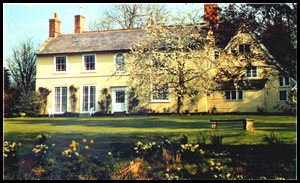  |
 |
 |
 |
 |
| Sun 28 Dec 2025 |

The History Of All Saints' WickhambrookWickhambrook - The VillageThe present parish, six miles long and four miles wide, is ten miles SW of Bury St Edmunds and about the same distance from Newmarket and Haverhill. There is a brook leading to the River Glem and this rises between the church and the Badmondisfield estate. The parish lies on heavy boulder clay except near the church. The village comprises a number of small hamlets known as greens which are scattered across a wide area well to the west of the church. These include Ashfield, Attleton, Baxters, Clopton, Coltsfoot, Farley, Genesis, Lady's, Meeting, Moor and Nunnery. Wickhambrook until the 1980s boasted a vineyard at Genesis where wine was produced. In Saxon times, the original village - known as Wickham - was probably clustered around the site where the church now stands. It is in an area of about ten acres of easily-worked silty gravel soil. This is quite different from the heavy land of the present village, which was covered by a vast impenetrable forest, being quite unsuited to tillage by the tools used by the Saxons. Because of the architectural and historical merit of the original village buildings that remain around the church, this part is now a Conservation Area. The White House opposite the church used to be an inn and until the 1980s the village doctor lived and ran his surgery there. In the 18th century, the Suffolk poet George Crabbe worked for a while in another doctor's surgery in a house almost opposite the Plumbers' Arms pub at the crossroads of the A143 - regrettably burnt down in the 1970s and replaced by a modern house. In 1783 Crabbe wrote The Village - a poem about the misery of rural poverty, probably drawing upon his experiences in Wickhambrook where he was unhappy (he had been born in more salubrious Aldeburgh on the Suffolk coast).
Immediately to the west side of the church are the almshouses, built in c. 1615 and now occupied by tenants of the diocese. Beyond these stands the new vicarage, a house which unfortunately is not in keeping with the period character of the area. Access to the old village would have been by paths alongside the brook which runs to the south of the church on the boundary of The Old Vicarage. This may well explain the disused 13th century door to the brook side of the chancel, also the connecting arch between the site of the Saxon chapel and the chancel. The door to the nave on the south side also faces the brook and there was probably a path from here to the brook across the small paddock in The Old Vicarage grounds. When the Revd William Nesfield was vicar, at the beginning of the 19th century, he blocked the arch - the original priest's door - and had a wall built across the north aisle, raised the floor of the chancel and removed the centre light of the window - in its place he had a door added to make it easier to walk from the vicarage to the church. This he admitted to doing after being admonished by the Archdeacon of the day. His letter explaining the vandalism is still extant in Bury St Edmunds. The vicar in the early 1960s, the Revd John Hodgson, removed the vestry that had resulted from these changes and made way for the Chapel of Peace which the church now enjoys. |

 The
The 